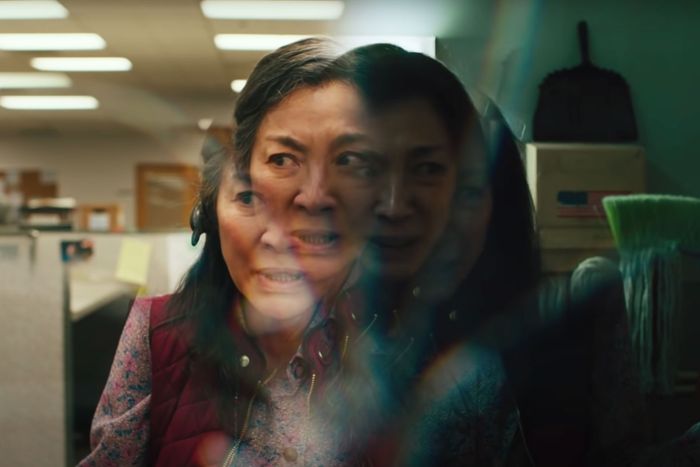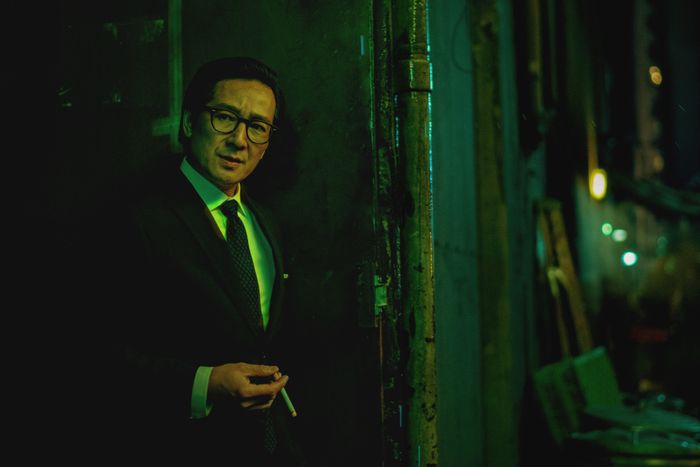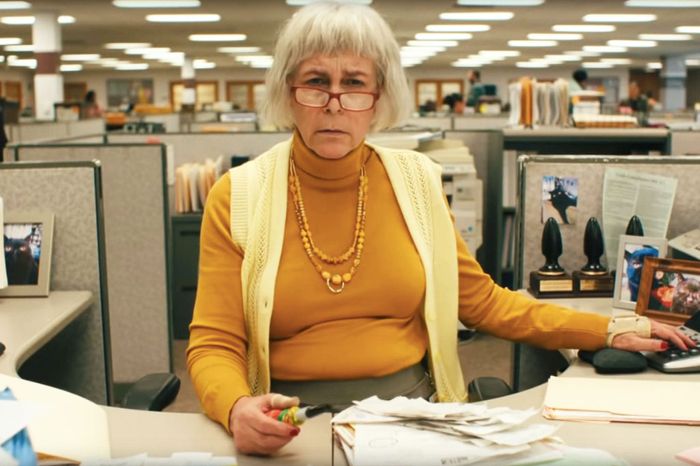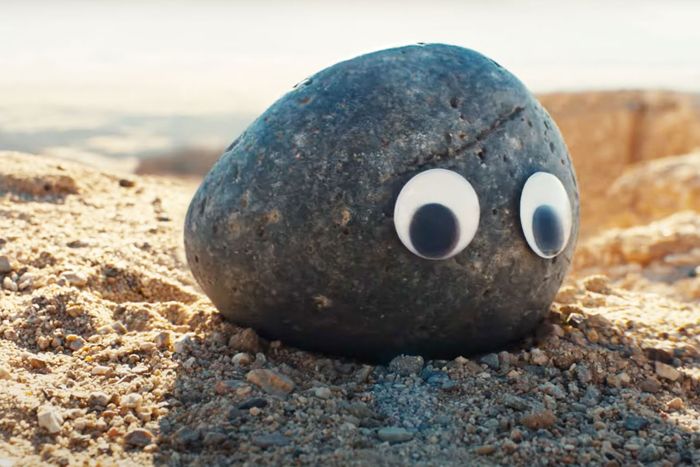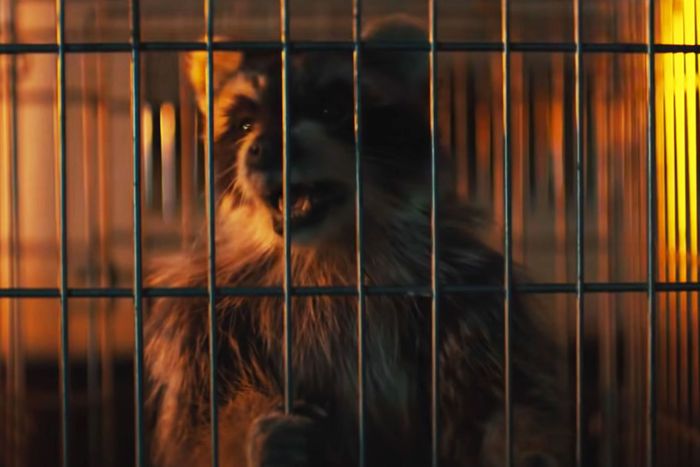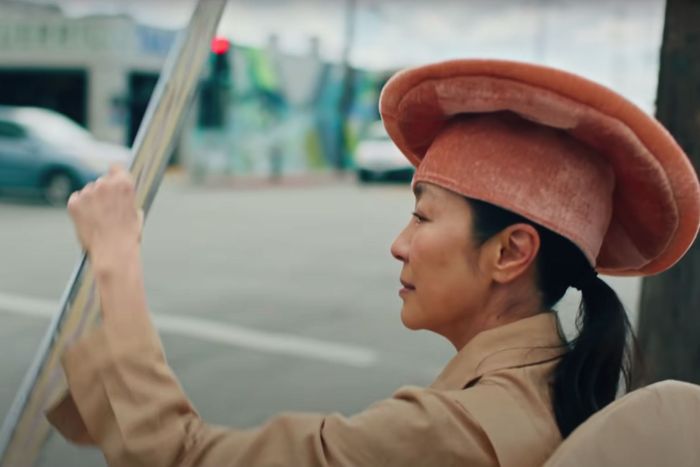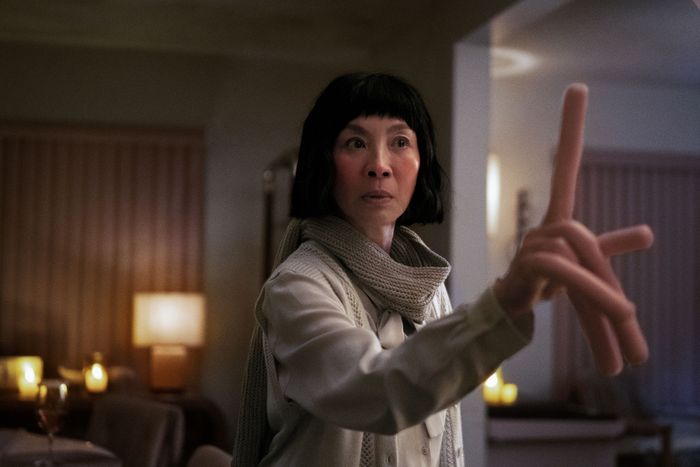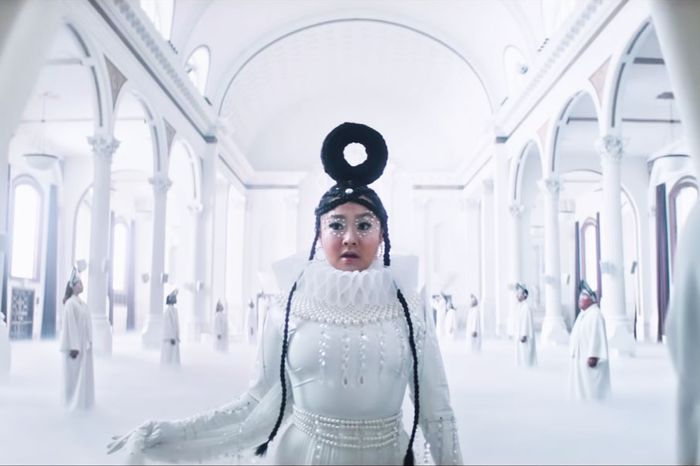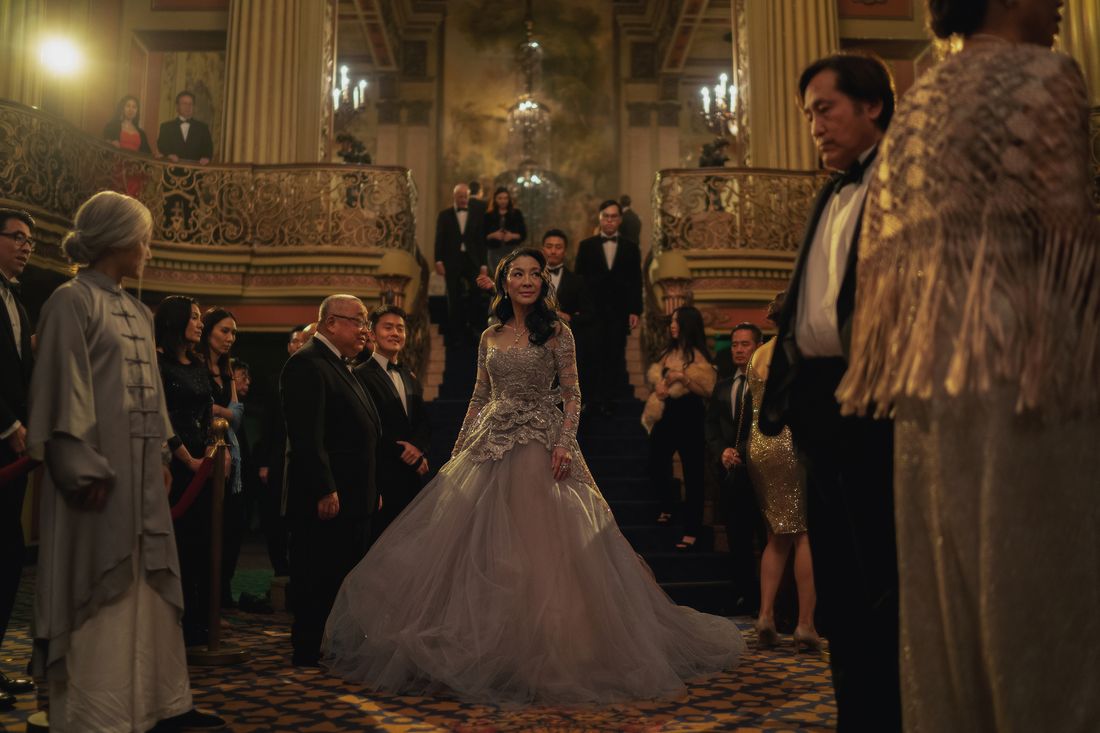
Warning: Spoilers! Moreover, this post won’t make a ton of sense if you haven’t seen the movie.
In the mind-bend-y, meta-narrative, sci-fi/comedy-drama/martial arts extravaganza Everything Everywhere All at Once (which arrived to ecstatic reviews in theaters nationwide Friday), it is perhaps fitting that an everything bagel — of all things — should be deployed as a doomsday device. Michelle Yeoh plays Evelyn, a scatterbrained laundromat owner with mounting debt and a crumbling marriage, who finds herself unwittingly thrust into the multiverse: literally tripping and kung-fu kicking her way across multiple dimensions, tapping into the power of alternate selves via “verse jumping” and, incidentally, trying to prevent the destruction of reality as we know it. The vehicle for that destruction: an obnoxiously literal bagel created by Evelyn’s nemesis, the nihilistic god-queen Jobu Tupaki (Stephanie Hsu), imbued with the power to suck everything into its black-hole-like vortex of nothingness. Um … yeah!
EEAAO’s writer-directors, Daniels — Daniel Kwan and Daniel Scheinert — cram in a truly absurd number of outside cinematic references, visual allusions, non sequiturs, in-jokes, and cultural flotsam harvested from distant fringes of the internet because, as they put it, “This movie is about everything.” The pair single out Hong Kong cinematic sensualist Wong Kar-wai (for whom Everything Everywhere All at Once co-star Ke Huy Quan formerly served as as an assistant director) for special appreciation, along with the chef-protagonist of the animated rat romp Ratatouille (who is chopped and screwed by Daniels into a deliciously bizarre anthropomorphic animal called Raccacoonie).
The self-described “maximalist filmmakers” rose to fame directing such sublimely insane music videos as DJ Snake’s “Turn Down for What” (a twerking odyssey starring Kwan) and the Sundance Directors Award–winning surrealist dramedy Swiss Army Man (in which Daniel Radcliffe stars as a farting corpse). Here, they walk us through their inspirations — the magical thinking, scientific calculations, beloved relatives, appreciation for Asian American culture creators, and “competency porn” that resulted in Everything Everywhere All at Once.
The Multiverse
EEAAO unfolds within a multiverse where multiple iterations of the same character exist in separate but parallel planes of time and space but come into dynamic confrontation with one another.
Daniel Scheinert: I started doing research into the multiverse in 2010. I was watching the documentary Sherman’s March.
Daniel Kwan: In this weird, self-destructive movie, the documentarian/protagonist Ross McElwee is bouncing between women. But one he meets is a linguist and she talks about modal realism. And I started doing more research — radical learning — about the multiverse theory. Just the idea in almost every single art form or medium that there is a version where they’re trying to tackle infinity. Of course quantum physics has its own version of that. Mathematics has its own. So all these different mediums are trying to point towards infinity. That’s really appealing to us because we’re maximalist filmmakers. The multiverse became a vessel for us to point at infinity in a way that most other premises probably wouldn’t allow for.
Scheinert: As silly as our movies are, we enjoy reading pop science.
Kwan: Then, as we were working on the movie, Spider-Man: Into the Spider-Verse came out. It was a little upsetting because we were like, “Oh shit, everyone’s going to beat us to this thing we’ve been working on.”
Scheinert: I feel like Rick and Morty was the first.
Kwan: Yeah. It was actually hard to watch because we had already been working on the draft for a while. Watching the second season of Rick and Morty was really painful. I was like, “They’ve already done all the ideas we thought were original!” It was a really frustrating experience. So I stopped watching Rick and Morty while we were writing this project.
The Cinematic Language of Wong Kar-wai
In one alternate universe, the disheveled Evelyn is an A-list movie star and her nerdy, fanny pack–wearing husband, Waymond, is an illustrious businessman resplendent in a perfectly tailored suit. They meet for a street-corner rendezvous backdropped by falling rain and a saxophone soundtrack — conjuring a mood of exquisite romantic yearning that will be instantly recognizable to the Criterion Collection set as touchstones of Hong Kong art-house auteur Wong Kar-wai.
Kwan: We could have easily gone into parody with this. A lot of time when people are doing allusions, they’re usually shooting for the most recognizable references so that everyone can be like, “Oh, I know what that is and now I’m in on the joke.” This was less about parody and more just playing with the genre, playing with all the things that we love and using the multiverse to let them all collide.
Scheinert: Wong Kar-wai leans heavily on imagery, not just dialogue. So we were just trying to create a shorthand for the audience even if they don’t get the reference. We wanted to make sure they had some ways to tell the universes apart.
Kwan: We both grew up loving kung-fu movies, loving anime, Wong Kar-wai, all these things. A lof of it just happens to be Asian: Asian stories made by Asian creators.
Scheinert: Those stories, those filmmakers, and those movies felt useful to pair up with these characters.
Butt Plugs
The movie’s craziest fight sequence takes place in an IRS auditors’ office where Evelyn — now possessed of high-level kung-fu skills — must face off against guards attempting to level up against her by bearing down, rectum first, on IRS trophies shaped like sex toys in order to unleash hidden strength and combat capacities.
Scheinert: Late in the writing process, Dan pointed out that, in this concept of “verse-jumping” where you have to do something crazy or strange or statistically unlikely to jump, we never had a scene where anyone was fighting over the weird action. We didn’t milk the premise as much as we could.
Kwan: The trope is usually two people are fighting and then the gun gets knocked out of the hand and then they’re struggling to fight over the gun.
Scheinert: It’s like the doomsday device: What would be the weirdest thing to fight over? We spitballed and settled onto — trying to get something into your butt is pretty funny. We could do it very high stakes. But it could also be Jackie Chan playful.
Rocks
Late in the film, Evelyn and her daughter, Joy (Stephanie Hsu) — who is also Jobu Tupaki — verse-jump away from the Sturm und Drang of previous scenes to a universe where they can peacefully coexist as small, round boulders overlooking a gorgeous Grand Canyon–esque vista. But of course the mother-daughter bickering does not end there.
Kwan: The rock thing comes from a confluence of things. There’s a children’s book called Sylvester and the Magic Pebble. A donkey turns into a rock and basically is isolated from his family. One of our friends is an animator and video-game maker named David OReilly. He made this game called Everything. It’s a game where you can literally play as anything. Literally, you can be a toenail clipping, you can be a fire hydrant, you can be an antelope, you can be a rock. And there’s maybe a dozen different kind of rocks you can be. Just rolling around —
Scheinert: — just feels good.
Kwan: It feels good and that is really beautiful. The whole purpose of the game is you have to look at it and not press anything. It’s a game where the longer you don’t press anything —
Scheinert: — the more you progress.
Kwan: He called it a relax-’em-up instead of a shoot-’em-up. The last thing is, I remember when I was really young, my first girlfriend ever said something that always stuck with me. “Sometimes I just wish I was a rock. So I didn’t have to feel everything.” As we were working on this movie about noise and chaos, we realized we needed a moment where we can give people the opposite. And what better place than a universe where life doesn’t exist?
Pixar’s Ratatouille
Occupying a universe in which she is a hibachi chef, Evelyn uses knife and spatula-wielding prowess to nimbly fend off attackers. Her restaurant rival: a handsome young grill man (Harry Shum Jr.) with a suspicious raccoon tail sticking out from beneath his chef’s toque. Turns out an anthropomorphic raccoon — named Raccacoonie — manipulates his actions behind the stove in much the same way Remy the rat controlled Alfredo Linguini in Ratatouille.
Scheinert: There were a lot of steps in the development of that joke. Our producer Jonathan Wang, his dad was Chinese and an inspiration for the movie. He loved movies but never could remember the names of them. Jon’s family would collect the different titles that Dad had come up with for movies. One time he was like, “Oh I saw a very good movie called Shooky Shylock.” They were like, “What is Shooky Shylock?!” He was like, “It’s like Iron Man but he’s a detective and he solves crimes in London”; it was Sherlock Holmes. His favorite one was Outside Good People Shooting and it took him a while to figure out that he had seen Good Will Hunting. So early days, we thought Evelyn could be similar. Then the idea that whatever she got wrong was real was a very exciting way to explore the multiverse.
Kwan: The Waymond character says, “If you can imagine it, then somewhere out there it exists.” We realized there has to be a scene in which Michelle rides the guy and controls him like Ratatouille. That whole thing becomes its own arc. That’s always when we know a joke is going to be worth pursuing — when first the idea is so ridiculous that we can’t stop thinking about it. Then we find a way to clean it up and close it off with something that’s epic and beautiful and cathartic or whatever. Then the last cherry on top was we always imagined Randy Newman would be the voice.
Scheinert: In the first draft it said, “There’s a raccoon on his head voiced by Randy Newman.” We never thought we’d get Randy but we did!
Benihana/Teppanyaki Cooking
Scheinert: Initially it was just a chef. Then there was a moment where we started getting self-conscious about some of the Asian American tropes that are in the film. At the same time, so many of them were just true. Dan would be like, “That is what my grandad’s laundromat looked like.” Then we started embracing them and just getting excited about complicating them and making them fun and different and taking things that are usually just a punchline and living in them a little longer. Also: Hibachi chefs are awesome!
Kwan: They’re just badasses as far as the skill goes. French chefs would lose in a fight against a Japanese steakhouse chef, obviously. It was a very visual, fun idea inspired by going to those birthday parties growing up with the flaming onion candles or whatever.
Scheinert: Oh my God, that blew my mind as a kid. I was like, “Why isn’t every restaurant like this?”
Human Directionals
With a SWAT team closing in on her and Waymond, Evelyn unlocks her potential as a sign-spinner — a.k.a. a human billboard; one of those people you see on street corners dancing and acrobatically flipping their sign like a pair of nunchucks — to dispatch and disarm a cohort of heavily armed men.
Kwan: We spend so much time on YouTube or Instagram and all the things that rise to the top are people being exceptional. There’s a term for it: competency porn. People love watching people who are competent at what they do. When we were working on this movie, I could just look up competency-porn montages and see people doing incredible stuff. You see sign-spinners and knife-twirlers and —
Scheinert: — people who lay bricks perfectly. There’s some people who can do it so fast.
Kwan: That would have been a universe. Someone’s coming at her and she just builds a wall.
Scheinert: We got excited about specifically tapping into a lot of universes where someone has a really impressive skill but it’s one that is often overlooked or underpaid. That was more interesting than going to a universe where she’s a brilliant mathematician —
Kwan: — or a CIA agent. It was way more fun to just make the everyday normal person feel like a superpower. Then you pair that with the fact we knew the fight scene was going to be with riot shields and things like that. People have been using shields to fight for a while. Obviously Captain America has been doing that. But we just wanted to have a very playful take. Our choreographers did such a good job with that prompt. We’re like, “What can you do with the sign?”
Scheinert: Michelle really had to practice her human directional skills.
Hot Dog Hands With Ketchup- and Mustard-Squirting Fingers
The movie’s most surreal subplot involves a world in which humanity has evolved to possess comically elongated sausage fingers. Evelyn finds herself in a romantic relationship with her IRS auditor, Deirdre (Jamie Lee Curtis), in this universe. And as an expression of love, the two shoot ketchup and mustard out of their fingertips into one another’s mouths.
Kwan: It’s not an original idea. If you look online, you’ll see people sticking fake nails on hot dog fingers and stuff like that. I think there is something very funny about the idea that our fingers look like hot dogs. But we weren’t interested in them until we figured out what the full arc was. Again, there’s a funny initial joke but then you have to wonder, Okay, what purpose is it serving? And ultimately, am I going to get something really meaningful or cathartic on the other end of it? We don’t really fully commit to an idea until the whole thing starts to come alive.
Scheinert: We wanted to take Evelyn somewhere that would break her brain, somewhere that she’d hate. She’d be like, No this universe does not exist, and we threw a lot at the wall. The idea stuck because of the visual and we were like, “She will look around herself and she will be like, ‘That is my auditor. I already hate her. And she has gross hands and she is trying to touch me.’” Then we wanted it to be as challenging as possible to make her accept this universe. So getting her to the place where she consents to the mating ritual and squirts herself with the hot dog and mustard — that was the goal. Can we get her there? We had to get Michelle there too. We had to convince her that it was worth doing.
I think she was like, “Okay maybe. I’ll see.” Ultimately, it was Jamie — the fact that Jamie agreed to do it gave Michelle the confidence to be like, “Alright.” Jamie did the final dance first and then was like, “Your turn, Michelle.”
The Everything Bagel
Kwan: There’s a scientific calculation you can do for any object in the universe called a Schwarzschild radius, an object that when you compress it down to that radius becomes a black hole. It becomes a singularity and it’s hypothetical. But the idea is, at a certain density, anything will become a black hole. So everyone has their Schwarzschild radius. Wouldn’t it be funny if she did that to an everything bagel? Because this movie is about everything. It started as just a throwaway joke.
Scheinert: We spent a while inventing the religion of the bagel followers. So many things didn’t stick. She’s a nihilist; should there be dogma? Should there be a book? What should their practices be as a religion? The bagel stuck because it became such a useful, simple symbol that we could point to as filmmakers. And you don’t have to explain it much beyond the joke.
Kwan: It did two things. It allowed us to talk about nihilism without being too eye roll-y. And it creates a MacGuffin: a doomsday device.
If in the first half of the movie people think that the bagel is here to destroy the world, and in the second half you realize it’s a depressed person trying to destroy themselves, it just takes everything about action movies and turns it into something more personal. Again, like all our ideas, it starts as a kernel that just makes us laugh. And then the gravity of that idea starts to pull in all these other things, until it becomes its own thing that we can’t even take credit for sometimes. This became what it had to become and I can’t imagine it being any different now.
More on Everything Everywhere All at Once
- Who Would Win an Actual A24 Civil War?
- The Best Movies That Lost Best Picture at the Oscars
- Every Oscar Best Picture Winner, Ranked



